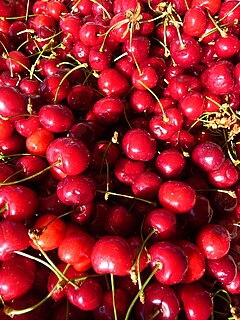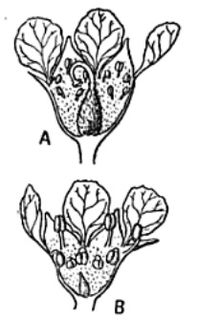
The almond is a species of tree native to Iran and surrounding countries, but widely cultivated elsewhere. The almond is also the name of the edible and widely cultivated seed of this tree. Within the genus Prunus, it is classified with the peach in the subgenus Amygdalus, distinguished from the other subgenera by corrugations on the shell (endocarp) surrounding the seed.

A cherry is the fruit of many plants of the genus Prunus, and is a fleshy drupe.

Prunus is a genus of trees and shrubs, which includes the fruits plums, cherries, peaches, nectarines, apricots, and almonds.

Prunus laurocerasus, also known as cherry laurel, common laurel and sometimes English laurel in North America, is an evergreen species of cherry (Prunus), native to regions bordering the Black Sea in southwestern Asia and southeastern Europe, from Albania and Bulgaria east through Turkey to the Caucasus Mountains and northern Iran.
Flowering almond is a common name for several plants and may refer to:

Lavandula angustifolia, formerly L. officinalis, is a flowering plant in the family Lamiaceae, native to the Mediterranean. Its common names include lavender, true lavender or English lavender ; also garden lavender, common lavender, and narrow-leaved lavender.
Pseudomonas amygdali is a Gram-negative plant pathogenic bacterium. It is named after its ability to cause disease on almond trees. Different analyses, including 16S rRNA analysis, DNA-DNA hybridization, and MLST clearly placed P. amygdali in the P. syringae group together with the species Pseudomonas ficuserectae and Pseudomonas meliae, and 27 pathovars of Pseudomonas syringae/Pseudomonas savastanoi, constituting a single, well-defined phylogenetic group which should be considered as a single species. This phylogenetic group has not been formally named because of the lack of reliable means to differentiate it phenotipically from closely related species, and it is currently known as either genomospecies 2 or phylogroup 3. When it is formally named, the correct name for this new species should be Pseudomonas amygdali, which takes precedence over all the other names of taxa from this group, including Pseudomonas savastanoi, which is and inadequate and confusing name whose use is not recommended.
Prunus korshinskyi is a species of Prunus in the family Rosaceae. It was first discovered in Syria, and is also locally native in Turkey and southeastern Europe. It is threatened by habitat loss. It is a deciduous shrub growing to 3.5 m tall, related to the almond.

Prunus fruticosa, the European dwarf cherry, dwarf cherry, Mongolian cherry or steppe cherry is a deciduous, xerophytic, winter-hardy, cherry-bearing shrub. It is also called ground cherry and European ground cherry, but is not to be confused with plants in the distinct "Groundcherry" genus of Physalis.

Prunus subg. Prunus is a subgenus of Prunus. This subgenus includes plums, apricots and bush cherries. Most species inside this subgenus are sugary, storing large amounts of energy which is why most Prunus species are soft and rubbery. Some species conventionally included in Prunus subg. Amygdalus are clustered with plum/apricot species according to molecular phylogenetic studies. Shi et al. (2013) has incorporated subg. Amygdalus into subg. Prunus, thereby including almonds and peaches in this subgenus.

Prunus glandulosa, called Chinese bush cherry, Chinese plum, and dwarf flowering almond, is a species of shrub tree native to China and long present in Japan. It is commonly used as an ornamental tree and for cut flowers.

Prunus texana, called peachbush, Texas almond cherry, Texas peachbush, sand plum, peach bush, and wild peach is native to central and western Texas. Although it looks like peach, it actually belongs to Prunus sect. Prunocerasus together with other North American plum species.

Prunus minutiflora, called the Texas almond, is a shrub native to Texas and northern Mexico.

Prunus pedunculata is a species of Prunus known in China as long‑peduncled almond (长梗扁桃). It is native to China, Mongolia and nearby sections of Siberia. A small bush, reaching 1-2 m, its pink flowers allow it to be used as an ornamental. Adapted to cold, arid environments, its many‑stemmed growth habit fixes blowing sand, an important contribution to succession. As Amygdalus pedunculatus Pall., it seems to be being evaluated for its seed oil potential.
Prunus trichamygdalus is a putative species of "wild" almond tree native to eastern Anatolia in Turkey, and nearby areas of Iran. Molecular and morphological analyses show that is very similar to Prunus dulcis, the cultivated almond, differing in its shorter petioles and smaller leaves with more numerous crenulations. Its flowers are pink, and its fruits green. Non-bitter forms may be cultivated, but its native range is restricted to elevations of 1250-2100 m on limestone slopes and gorges in the Lake Van area.
Prunus mongolica is a species of Prunus native to China and Mongolia, particularly the Gobi Desert. A small scrubby bush, reaching 1-2 m, it is adapted to extreme drought. Genetic studies have shown that it is more closely related to the peaches, with its closest relative being Prunus tangutica.
Prunus elaeagrifolia is a species of wild almond native to Iran. It is shrub or small tree 3-4 m tall, with the gray bark of its older twigs peeling in places and showing a brownish-yellow underbark. Its leaves are densely pubescent, with the pubescence yellowish gray. It is mostly found in the southern portion of the Zagros Mountains, where in places it is one of the dominant tree species. Its 2n=16 chromosomes have karyotypic formula 7m+t.
Prunus turcomanica, the Turkmen almond, is a putative species of wild almond native to Iran, Turkmenistan and possibly eastern Turkey. A genetic and morphological study has shown that it is conspecific with Prunus spinosissima.

Prunus sect. Microcerasus is a section of Prunus. It used to be included in Prunus subg. Cerasus, but phylogenetic research indicates it belongs to Prunus subg. Prunus. It differs from Prunus subg. Cerasus by having three winter buds per axil.













